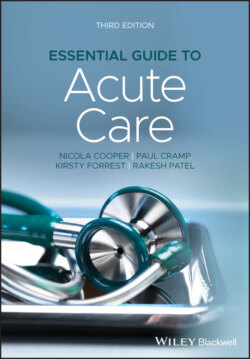Читать книгу Essential Guide to Acute Care - Nicola Cooper - Страница 22
Box 1.3 The ABCDE System
ОглавлениеAirway
Examine for signs of upper airway obstruction
If necessary, do a head tilt‐chin lift manoeuvre
Suction (only what you can see)
Simple airway adjuncts may be needed
Give oxygen if needed (see Chapter 2 for more details)
Breathing
Look at the chest
Assess rate, depth, and symmetry of movement
Measure SpO2
Quickly listen with a stethoscope (for air entry, wheeze, crackles)
You may need to use a bag and mask if the patient has inadequate ventilation
Treat wheeze, pneumothorax, fluid, collapse, infection, etc. (is a physiotherapist needed?)
Circulation
Assess limb temperature, capillary refill time, blood pressure, pulse, urine output
Insert a large bore cannula and send blood for tests
Give a fluid challenge if needed (see Chapter 5 for more details)
Disability
Make a note of the AVPU scale (alert, responds to voice, responds to pain, unresponsive)
Check pupil size and reactivity
Measure capillary glucose
Examination and Planning
Are ABCD stable? If not, go back to the top and call for help
Complete any relevant examination e.g. heart sounds, abdomen, full neurological exam
Treat pain
Gather information from notes, charts, and eyewitnesses
Do tests e.g. arterial blood gases, X‐rays, ECG
Do not move an unstable patient without the right monitoring equipment and staff
Make ICU and CPR decisions
You should have called a senior colleague by now, if you have not done so already.
Patients with serious abnormal vital signs are an emergency. The management of such patients requires proactivity, a sense of urgency, and the continuous presence of the attending doctor. For example, if a patient is hypotensive and hypoxaemic from pneumonia, it is not acceptable for oxygen, fluids, and antibiotics simply to be prescribed. The oxygen concentration may need to be changed several times before the PaO2 is acceptable. More than one fluid challenge may be required to get an acceptable blood pressure – and even then, vasopressors may be needed if the patient remains hypotensive due to septic shock. Intravenous antibiotics need to be given immediately. ICU and CPR decisions need to be made at this time – not later. The emphasis is on both rapid and effective intervention.
Integral to the management of the acutely ill patient is the administration of effective analgesia. This is extremely important to the patient but also has a range of physiological benefits and is discussed further in Chapter 10.
